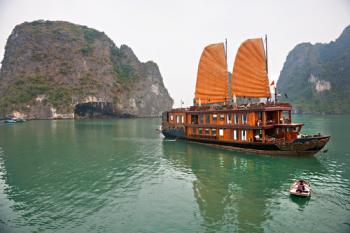Geneva Conference (1954)
What did the Geneva Conference (1954) Address?
The Geneva Conference (1954) approached conflicts in Indochina and attempted to unify the north and south of Vietnam. The conference lasted from April 26 to July 20 of 1954, and the following countries attended the conference: United States, Soviet Union, France, United Kingdom, and the Peoples Republic of China.
The Conference also addressed North and South Korea, but Korea remained divided after the wars were ended between France and the Viet Minh. The Peoples Republic of China and the Soviet Union accused the United States of restricting the combination of North and South Korea into a Communist State.
By the end of the Geneva Conference (1954), three cease fires were signed for Vietnam, Laos, and Cambodia, and agreements split Vietnam into two different territories. The north was controlled by the Viet Minh, and the south was controlled by the State of Vietnam. The Geneva Agreements were signed on July 1, 1954.
Summary of the Provisions under the Geneva Conference (1954)
The Final Declaration included 13 different sections, and these are paraphrased below:
Section 1: Hostilities in Cambodia, Laos, and Viet-Nam come to an end.
Section 2: Cambodia, Laos, and Viet-Nam now have full independence and sovereignty.
Section 3: General elections for Cambodia and Laos shall take place in 1955 by secret ballots.
Section 4: Foreign troops and military personnel are prohibited in Viet-Nam, and Cambodia and Laos request no foreign aid.
Section 5: No military bases of a foreign state shall be established in the regrouping zones for the two parties in Viet-Nam. Additionally, Cambodia
and Laos have agreed that they will not join in any military alliance that is not chartered by the United Nations.
Section 6: The demarcation line in Viet-Nam is established to end hostilities but she not be interpreted as a political or territorial boundary.
Section 7: Elections will be held in Vietnam by a secret ballot and shall be held in July of 1956. The two sides will consult on this issue from April 20, 1955 and onward.
Section 8: The end of hostilities in Viet-Nam ensures that everyone in Viet-Nam has the freedom to decide which zone to live in.
Section 9: The northern and southern zones of Viet-Nam, including authorities in Laos and Cambodia, shall not take action against a person or their family members who collaborated with a certain party during the war.
Section 10: The French Government agrees to withdraw its troops from Cambodia, Laos, and Viet-Nam. At the request of a government, a certain number of French troops can remain in a specific area for a certain amount of time.
Section 11: The French Government will continue to respect the sovereignty and territories of Cambodia, Laos, and Viet-Nam.
Section 12: Every member of the Geneva Conference (1954) agrees to respect the sovereignty of the mentioned states and will not interfere with their internal affairs.
Section 13: Members of the Conference agree to consult with each other to make improvements to the agreements that helped end hostilities in Cambodia, Laos, and Viet-Nam.
Source: http://www.fordham.edu/halsall/mod/1954-geneva-indochina.html
Related Topics
- Louisiana Unemployment Benefits
- Magnusson-Moss Warranty Act Text
- Clinger-Cohen Act Text
- Miller Test
- Puerto Rico Disability Benefits
- Who Is John Kerry
- Colorado Unemployment Benefits
- Reconstruction Act of 1867 Text
- Post Office Locator
- Overview of The Disability Rights Movement
